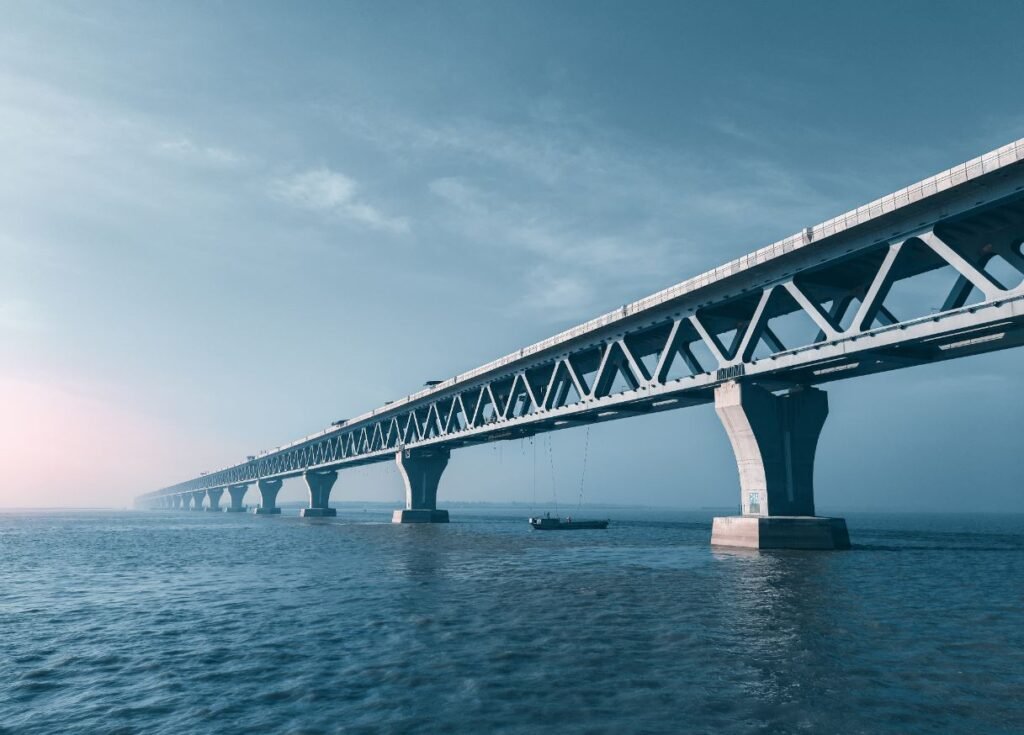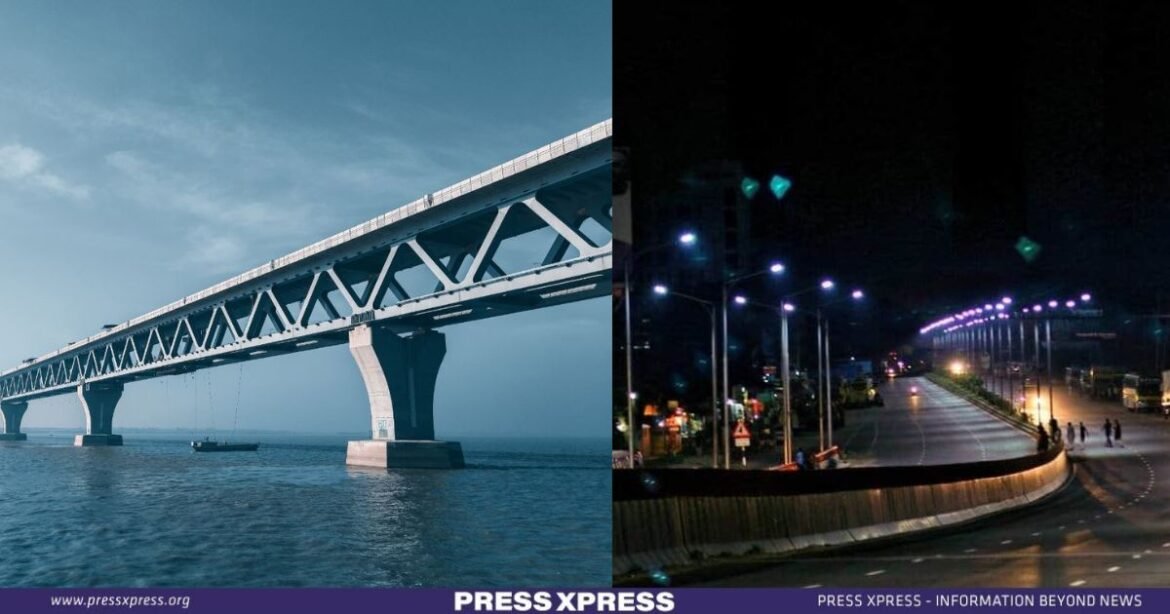In the tapestry of Bangladesh’s infrastructure evolution, the story of bridges and flyovers unfolds as a symphony of connectivity, progress, and transformation
The emphasis on connectivity initiatives is widely acknowledged as a crucial prerequisite for advancing the transportation sector, fostering interpersonal connections, establishing institutional ties, and ultimately fueling economic development. Emerging in the mid-20th century, the concept of regional and sub-regional cooperation embodies the understanding that no nation, regardless of its size or wealth, can achieve economic prosperity in solitude.
It’s noteworthy that not all roads adhered to the standard two-lane configuration until 2008. Subsequently, in 2009, the government devised comprehensive plans to upgrade existing two-lane highways to meet appropriate standards and widths. Furthermore, efforts were directed toward enhancing national highways, with the goal of expanding those to four lanes or more. This strategic move aimed to enlarge the country’s transportation infrastructure and overall connectivity.
Between 2009 and 2023, the construction of 1,131 bridges spanning 193,154 meters and 4,315 culverts covering 23,062 meters has been successfully accomplished through various developmental initiatives. This concerted effort aims to ensure the seamless flow of traffic on the highway. The erection of these bridges has not only facilitated uninterrupted travel but has also contributed to a time-efficient and secure road transport infrastructure.
How Key Bridges Shape Sub-Regional Synergy

Marking a significant milestone, the 6.15km-long Padma Multipurpose Bridge takes its place as the longest in South Asia. Its establishment has created a steadfast and safe route from Mawa to Janjira over the Padma River, drastically reducing the commute time from four hours by ferry to a quick 10-minute trip across the bridge. This transformative structure effectively connects the southwest region to the rest of the country, particularly the capital, Dhaka, catalyzing business growth and streamlining the movement of export goods between the Mongla seaport and other regions. As per one estimation, this improvement has propelled the national GDP to an annual growth rate of approximately one percent.
The “8th Bangladesh-China Friendship Bridge Construction Project on Kacha River” spans Bekutia, located 12 kilometers from Rajapur-Naikathi-Bekutia-Pirojpur Road, enhancing communication between Khulna and Barisal districts at a depth of 1493 meters. Named “Bangamata Begum Fazilatun Nesa Mujib,” the project was completed in the fiscal year 2022-23. The Prime Minister inaugurated the bridge on September 4, 2022, marking a milestone in regional connectivity and development.
Strategic infrastructure development has paved the way for the effective delivery of civic services to remote hilly regions, establishing connectivity to the last mile. The construction of bridges between 2009 and 2023 has resulted in the liberation of 33 major docks from reliance on ferries.
The Shitalakshya River is now traversed by the impressive 1070-meter-long Sultana Kamal Bridge, also known as the 2nd Shitalakshya Bridge. The bridge serves as a crucial conduit for vehicles traveling between Greater Sylhet, Kishoreganj, and Brahmanbaria, streamlining access to and from Dhaka.
Another noteworthy addition to Bangladesh’s infrastructure is the aesthetically pleasing Shah Amanat Bridge, an extradosed structure spanning over the Karnaphuli River. This bridge, designed to enhance travel convenience for those journeying to South Chattogram, Bandarban, and the tourist haven of Cox’s Bazar, stands as a testament to the country’s architectural prowess.
Facilitating uninterrupted road connectivity, the Teesta Bridge, stretching over 750 meters, now links Kurigram and Lalmonirhat districts to the national network. This infrastructure initiative directly addresses the communication challenges imposed by the Teesta River during the rainy seasons, providing a significant advantage to six upazilas in Lalmonirhat and Rangpur. Senior Vice-President of Rangpur Chamber, Mostoba Hossain Ripon, emphasized the bridge’s pivotal role in achieving seamless connectivity.
“Construction of the bridge on the Teesta has removed the decades old barrier by establishing direct road communication making movement of people easier and fulfilling another long-cherished hope of the local people”-he said.
Other mentionable Bridges constructed between 2009-2023 and their impacts
| Bridges | Impacts |
| Shaheed Abdur Rob Serniabat (Dopodia) bridge on the Kirtankhola river | Everyday thousands of vehicles use this bridge easing transportation on the Dhaka-Barisal-Patuakhali highway. |
| Dr. MA Wazed Mia Bridge | Removed traffic congestion on the connecting roads of Dinajpur, Rangpur, and Gaibandha districts. |
| Chhatak Surma Bridge | Replaced bailey,narrow and dilapidated bridges and enhanced connectivity on the Gobindaganj-Chhatak-Doarabazar highway. |
| Madhumati Bridge | This is the last missing link of the Asian Highway and has been constructed over the Madhumati River under the Cross-Border Road Network Improvement Project (Bangladesh) as part of sub-regional connectivity development. |
Flyovers Tackling Traffic Head-On, Easing Transportation
Flyover, a vital road structure strategically situated at intersections, serves as a pivotal solution to efficiently manage uninterrupted traffic flow, particularly within urban landscapes. Recognizing the imperative need to address transportation challenges in Bangladesh, the government has undertaken the construction of significant flyovers at key intersections across the country.
The Shaheed Ahsan Ullah Master Fly Bridge, spanning an impressive length of 350 meters, has been meticulously crafted along the inaugural kilometer of the Tongi-Kaliganj-Ghorashal-Panchdona highway. This engineering marvel stands as a testament to the government’s commitment to alleviating traffic congestion around the Tongi railway junction and the rail crossing within the Tongi industrial area.
In a parallel endeavor, a remarkable 1420-meter-long Chittagong Port link flyover has been brought to fruition. The primary objective behind this ambitious undertaking was to streamline and facilitate access to the Dhaka-Chattogram highway, particularly in connection with the pivotal Chittagong Port.

The Mohipal flyover, a formidable infrastructure project, spans 660 meters with six lanes, seamlessly integrating the Mohipal intersection of Dhaka-Chattogram National Highway and Feni-Noakhali Highway. Transforming a once-congested crossroads, the elevated expanse has upgraded the Dhaka-Chittagong National Highway section to four lanes, ensuring a fluid and unimpeded traffic flow.
Notable Rail-links and flyovers
| Rail-links and flyovers | Length | Cost |
| Banani rail crossing, Dhaka | 804 meters | 360 crores taka |
| Tangail and Manikganj highway link | 515.12 meters | 96 crores taka |
| Mourail Railway Overpass, Brahmanbaria | 896.13 meters | 77.21 crores taka |
| Shashongaccha rail-crossing overpass, Cumilla | 631.150 meters | 87.10 crores taka |
In the tapestry of Bangladesh’s infrastructure evolution, the story of bridges and flyovers unfolds as a symphony of connectivity, progress, and transformation. These bridges, stretching across rivers and valleys, are more than mere structures; they are lifelines weaving together the intricate fabric of a nation. From unlocking remote hilly areas to liberating major docks from ferry dependence, each bridge signifies a triumph over geographical barriers, a testament to engineering ingenuity, and a conduit for economic prosperity.
As we soar over the urban landscapes on the wings of flyovers, we witness the government’s commitment to tackling traffic head-on. These elevated marvels not only ease the flow of vehicles but also symbolize a commitment to efficiency, connectivity, and a vision of urban spaces free from congestion. The saga of these key bridges and flyovers is a testament to the power of connectivity in shaping sub-regional synergy, rural efficiency, and ultimately, the collective destiny of a nation on the move.


